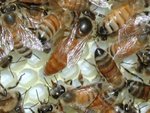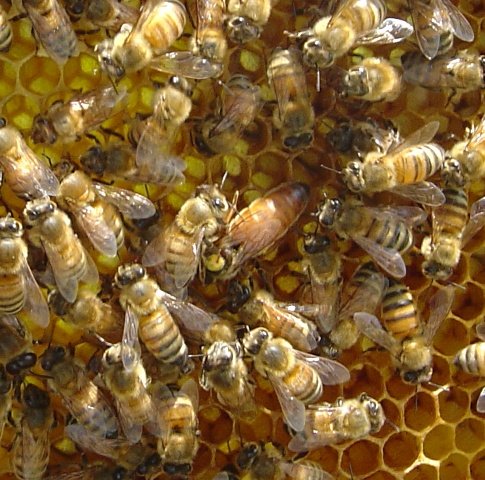Bee season summery.
Well. My last post on this bee blog is almost a year old. A year ago I stated that I would do a better job keeping up with monthly blog posts. I guess not!!
.
 .
.Left: Beautiful pattern of brood layed by one of my queens.
.
.
.
.
.
.
.
.
The 2009 honey season, here on Cape Cod, was a complete bust. Our nectar flow on the Cape is in the spring. It rained so much this spring that the bees could not take advantage of the abundant nectar that was available. This resulted in very little honey being produced by the bees.
.
 .
.Left: Larva and Eggs ready to be grafted into plastic queen cups
.
.
.
.
.
.
.
.
.
A hive of bees needs about 50 pounds of honey to survive the winter here on Cape Cod. In an average season the bees will produce about 110 pounds of honey. 60 of that will be taken by the beekeeper, and 50 left for the bees for winter. The honey production was so poor this year that, in August, the bees had no honey in the hives and were in danger of starving. A couple of hives actually had no honey or nectar at all in the hive. Usually at this time there would be at least 60 pounds of extra honey in the hive in addition to the 20 to 30 pounds that would be stored near the brood or young bees.
Never in my 32 years of keeping bees have I ever seen a condition like this. I was forced to feed each hive of bees about a gallon of sugar syrup to sustain them. Fortunately it has been a good fall for the bees and we have been able to feed them substantially. The goldenrod has produced abundant pollen as for them as well. Even today bees were bringing in bright yellow packages of pollen to store for winter.
The verroa mite infestation has been the worst I’ve seen in years. This year I have gone back to treating the hives with chemical strips. The pesticide strips are designed to kill the mites but leave the bees alone. Thousands of mites are dropping out of the hives. Small hive beetle has been an issue as well. Fortunately not as bad as last year where I actually had bees leaving hives because they could not deal with the small hive beetle larva, which looks like groupings of small worms living in the combs.
.
 .
.Left: Queen larve foating in royal jelly. This larva was grafted into this cell 48 hours earler. The larva is 6 days old
.
.
.
.
.
.
.
.
.
The most disturbing incident however took place in March while I was installing two packages of bees we received from Georgia. Upon shaking the first package into an empty hive, I received a bee sting on my knee. As usual I brushed off my knee thinking that a bee just stung me from the outside of my pants leg. I finished installing the bees in the first hive and then continued to install the second package of bees in the second hive. Then I notice that my hands were burning. I thought to myself “That’s strange I don’t remember using these gloves for chemical or anything that would burn my hands”. I continued picking up and putting away my beekeeping equipment and noticed that my knee where I had been stung was still hurting… A lot. So I lifted up my pant leg and sure enough there was the stinger still in my knee pumping away. I removed it and noticed that one of my contact lenses felt strange. Then I started to itch all over. Sure enough… After keeping bees for 32 years, I now had developed an allergic reaction to the bee sting.
.
 .
.Left: Queen cells produced as part of my 2009 queen rearing project. This summer I raised 12 mated queens.
.
.
.
.
.
.
.
.
I got to take my first ride in an ambulance!







I see you are now posting in 2010 after becoming allergic in 2009. What have you done to be able to keep bees again in light of your first ride in an ambulance?
ReplyDeleteBeeactor: In responce to your question about the alergic reaction and what I have done. I considered giving up beekeeping (for about a minute) but couldn't. Beekeeping is a passion.... So I bought a full bee suit! I also never go to the apiary without an epipen, cell phone, and benadryl. Besides, I can think of worse ways to go then working with your bees in the beeyard!
ReplyDeleteMark, my allergic reaction is limited to blisters. My last sting was next to the nail of my index finger and the blisters extended down my finger.
ReplyDeleteHow did your allergy develop? Should I worry? :-)
Steve
ps - great blog! I hope to rear queens in the next couple of years. Starting this year with removing swarm cells and rearing them.
Stephen:
ReplyDeleteI was installing two packages of bees last April. After I shook the bees over the queen from the first package, I felt a sting on my knee (I was wearing only a veil and gloves, no bee suit). I just figured I got stung from the outside of my pant leg. So I just brushed it off and continued to the next package. By the end of that install I felt my hands burning. I thought to myself "did I use these gloves for formic acid treatments last season?... No" Then I noticed one of my contact lenses were bothering me, then I started to get hot and itch all over, and my knee still hurt! I lifted up my pant leg to find a stinger still pumping away. I went inside and looked in the mirror... My eye and face were swolen and I had hives on my chest.
Yea... It could happen anytime. I've been stung a few times over the past 30 years with only the usual results. That one sting just put me over the edge.
Watch yourself.
But don't let the bees think your afraid! HA!
I'm doing a report on CCD and I found this site while gathering research. Thanks for having it! I just wanted to let you know that the 2010 CCD "breakthrough" is probably just a farce. Other Scientists have already ripped it apart as not truly proving anything, upon closer inspection of their methods of gathering data. Not to mention that the the lead author of the PLoS one report, Jerry Bromenshenk, backed out of a law suit in which he was to be an expert witness for the beekeepers who were suing Bayer Crop-Science over imidacloprid in 2003. He also received a “grant” from Bayer after dropping out of the suit as witness, and the cherry on the cake, good ole Jerry owns a company which would benefit if the cause of CCD were blamed on a virus and not an insecticide. (Hello professor Kohon, professor LaCommare, I wrote this, I didn't plagiarize it! :)
ReplyDeleteAnyway - you should check out http://www.cbgnetwork.org/2821.html
This article was very interesting, as was the rest of the site. I'm seriously considering a boycott of all that is Bayer! Good luck with your Bees and your unfortunate new allergy :(
You may be interested in my site, detailing the ongoing damage being caused by systematic failure to use selective husbandry techniques. raising new bees from unadapted/unhealthy parent bees will always cause the same problems - or worse - in the next generation. Beekeepers must learn to do what is routinely done, and recognised as uttely essential in all other forms of animal husbandry, and select only the best for reproduction.
ReplyDeleteThe widespread failure to do so simply and amply explains the perpetual nature of the health problems.
Best wishes,
Mike Bispham
Mike:
ReplyDeleteThank you... You have a very good site. After reading it I will modify some of the things I am doing here.
I recommend it to everybody...
Mark